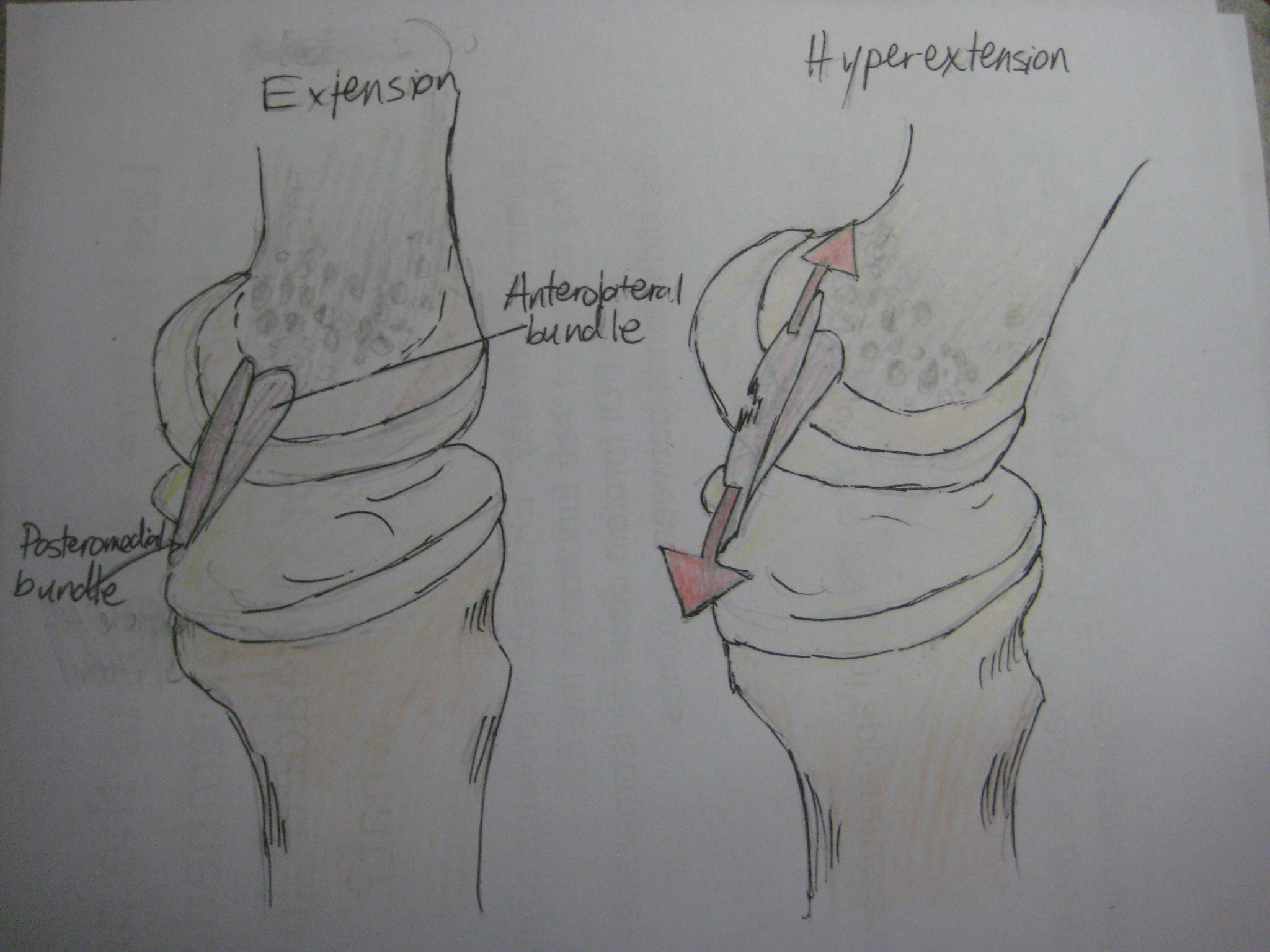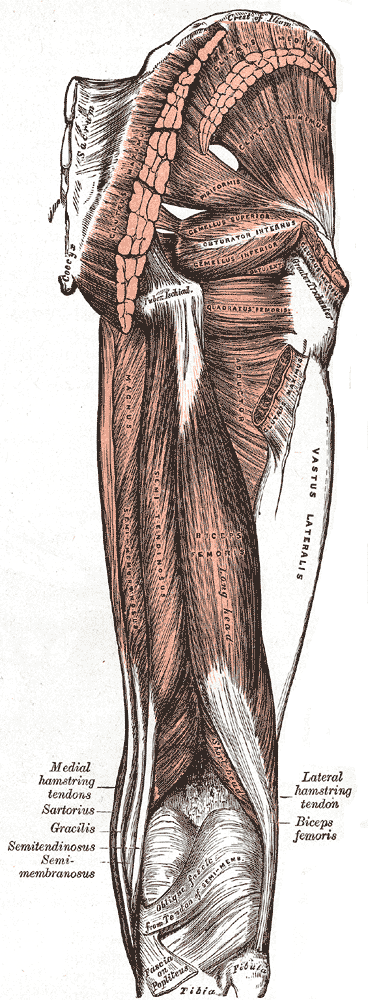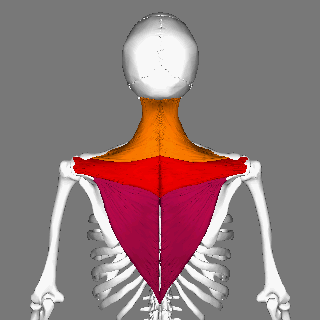|
Squat (exercise)
A squat is a strength exercise in which the trainee lowers their hips from a standing position and then stands back up. During the descent, the hip and knee joints flexion, flex while the ankle joint dorsiflexion, dorsiflexes; conversely the hip and knee joints extension (anatomy), extend and the ankle joint plantarflexion, plantarflexes when standing up. Squats are considered a vital exercise for increasing the strength and Muscle hypertrophy, size of the lower body muscles as well as developing core stability, core strength. The primary Anatomical terms of muscle#Agonist, agonist muscles used during the squat are the quadriceps femoris, the adductor magnus, and the gluteus maximus. The squat also Isometric exercise, isometrically uses the erector spinae and the rectus abdominis muscle, abdominal muscles, among others. The squat is one of the three lifts in the strength sport of powerlifting, together with the deadlift and the bench press. It is also considered a staple exerc ... [...More Info...] [...Related Items...] OR: [Wikipedia] [Google] [Baidu] |
Squats
Squat, squatter or squatting may refer to: Body position * Squatting position, a sitting position where one's knees are folded with heels touching one's buttocks or back of the thighs * Squat (exercise), a lower-body exercise in strength and conditioning Computing and the Internet * Cybersquatting, refers to registering Internet domain names similar to popular trademarks with the intent to extort the trademark holder * Squatting attack, a kind of computer attack Law and property *Squatting Squatting is the action of occupying an abandoned or unoccupied area of land or a building (usually residential) that the squatter does not own, rent or otherwise have lawful permission to use. The United Nations estimated in 2003 that there wer ..., the occupation of abandoned or unused building without the permission of the owner * Squatting (Australian history), historical Australian term referring to settlers occupying Crown land in order to graze livestock Media and entertainm ... [...More Info...] [...Related Items...] OR: [Wikipedia] [Google] [Baidu] |
Powerlifting
Powerlifting is a competitive strength athletics, strength sport that consists of three attempts at maximal weight on three lifts: Squat (exercise), squat, bench press, and deadlift. As in the sport of Olympic weightlifting, it involves the athlete attempting a maximal weight single-lift effort of a barbell loaded with weight plates. Powerlifting evolved from a sport known as "odd lifts", which followed the same three-attempt format but used a wider variety of events, akin to Strength athletics, strongman competition. Eventually, odd lifts became standardized to the current three. In competition, lifts may be performed equipped or unequipped (typically referred to as 'classic' or 'raw' lifting in the International Powerlifting Federation, IPF specifically). Equipment in this context refers to a supportive bench shirt or squat/deadlift suit or briefs. In some federations, knee wraps are permitted in the equipped but not unequipped division; in others, they may be used in both equip ... [...More Info...] [...Related Items...] OR: [Wikipedia] [Google] [Baidu] |
Posterior Cruciate Ligament
The posterior cruciate ligament (PCL) is a ligament in each knee of humans and various other animals. It works as a counterpart to the anterior cruciate ligament (ACL). It connects the posterior intercondylar area of the tibia to the Medial condyle of femur, medial condyle of the femur. This configuration allows the PCL to resist forces pushing the tibia posteriorly relative to the femur. The PCL and ACL are intracapsular ligaments because they lie deep within the knee joint. They are both isolated from the fluid-filled synovial cavity, with the synovial membrane wrapped around them. The PCL gets its name by attaching to the posterior portion of the tibia. The PCL, Anterior cruciate ligament, ACL, medial collateral ligament, MCL, and fibular collateral ligament, LCL are the four main ligaments of the knee in primates. Structure The PCL is located within the knee joint where it stabilizes the articulating bones, particularly the femur and the tibia, during movement. It originates ... [...More Info...] [...Related Items...] OR: [Wikipedia] [Google] [Baidu] |
Anterior Cruciate Ligament
The anterior cruciate ligament (ACL) is one of a pair of cruciate ligaments (the other being the posterior cruciate ligament) in the human knee. The two ligaments are called "cruciform" ligaments, as they are arranged in a crossed formation. In the quadruped stifle joint (analogous to the knee), based on its anatomical position, it is also referred to as the cranial cruciate ligament. The term cruciate is Latin for cross. This name is fitting because the ACL crosses the posterior cruciate ligament to form an "X". It is composed of strong, fibrous material and assists in controlling excessive motion by limiting mobility of the joint. The anterior cruciate ligament is one of the four main ligaments of the knee, providing 85% of the restraining force to anterior tibial displacement at 30 and 90° of knee flexion. The ACL is the most frequently injured ligament in the knee. Structure The ACL originates from deep within the notch of the distal femur. Its proximal fibers fan out alo ... [...More Info...] [...Related Items...] OR: [Wikipedia] [Google] [Baidu] |
Quadriceps
The quadriceps femoris muscle (, also called the quadriceps extensor, quadriceps or quads) is a large muscle group that includes the four prevailing muscles on the front of the thigh. It is the sole extensor muscle of the knee, forming a large fleshy mass which covers the front and sides of the femur. The name derives . Structure Parts The quadriceps femoris muscle is subdivided into four separate muscles (the 'heads'), with the first superficial to the other three over the femur (from the trochanters to the condyles): * The rectus femoris muscle occupies the middle of the thigh, covering most of the other three quadriceps muscles. It originates on the ilium. It is named for its straight course. * The vastus lateralis muscle is on the ''lateral side'' of the femur (i.e. on the outer side of the thigh). * The vastus medialis muscle is on the ''medial side'' of the femur (i.e. on the inner part thigh). * The vastus intermedius muscle lies between vastus lateralis and vas ... [...More Info...] [...Related Items...] OR: [Wikipedia] [Google] [Baidu] |
Femur
The femur (; : femurs or femora ), or thigh bone is the only long bone, bone in the thigh — the region of the lower limb between the hip and the knee. In many quadrupeds, four-legged animals the femur is the upper bone of the hindleg. The Femoral head, top of the femur fits into a socket in the pelvis called the hip joint, and the bottom of the femur connects to the shinbone (tibia) and kneecap (patella) to form the knee. In humans the femur is the largest and thickest bone in the body. Structure The femur is the only bone in the upper Human leg, leg. The two femurs converge Anatomical terms of location, medially toward the knees, where they articulate with the Anatomical terms of location, proximal ends of the tibiae. The angle at which the femora converge is an important factor in determining the femoral-tibial angle. In females, thicker pelvic bones cause the femora to converge more than in males. In the condition genu valgum, ''genu valgum'' (knock knee), the femurs conve ... [...More Info...] [...Related Items...] OR: [Wikipedia] [Google] [Baidu] |
Hip Joint
In vertebrate anatomy, the hip, or coxaLatin ''coxa'' was used by Celsus in the sense "hip", but by Pliny the Elder in the sense "hip bone" (Diab, p 77) (: ''coxae'') in medical terminology, refers to either an anatomical region or a joint on the outer (lateral) side of the pelvis. The hip region is located lateral and anterior to the gluteal region, inferior to the iliac crest, and lateral to the obturator foramen, with muscle tendons and soft tissues overlying the greater trochanter of the femur The femur (; : femurs or femora ), or thigh bone is the only long bone, bone in the thigh — the region of the lower limb between the hip and the knee. In many quadrupeds, four-legged animals the femur is the upper bone of the hindleg. The Femo .... In adults, the three pelvic bones (ilium (bone), ilium, ischium and pubis (bone), pubis) have fused into one hip bone, which forms the superomedial/deep wall of the hip region. The hip joint, scientifically referred to as t ... [...More Info...] [...Related Items...] OR: [Wikipedia] [Google] [Baidu] |
Hamstring
A hamstring () is any one of the three posterior thigh muscles in human anatomy between the hip and the knee: from medial to lateral, the semimembranosus, semitendinosus and biceps femoris. Etymology The word " ham" is derived from the Old English “ham” or “hom” meaning the hollow or bend of the knee, from a Germanic base where it meant "crooked". It gained the meaning of the leg of an animal around the 15th century. ''String'' refers to tendons, and thus the hamstrings' string-like tendons felt on either side of the back of the knee. Criteria The common criteria of any hamstring muscles are: # Muscles should originate from ischial tuberosity. # Muscles should be inserted over the knee joint, in the tibia or in the fibula. # Muscles will be innervated by the tibial branch of the sciatic nerve. # Muscle will participate in flexion of the knee joint and extension of the hip joint. Those muscles which fulfill all of the four criteria are called true hamstrings. ... [...More Info...] [...Related Items...] OR: [Wikipedia] [Google] [Baidu] |
Trapezius
The trapezius is a large paired trapezoid-shaped surface muscle that extends longitudinally from the occipital bone to the lower thoracic vertebrae of the human spine, spine and laterally to the spine of the scapula. It moves the scapula and supports the arm. The trapezius has three functional parts: * an upper (descending) part which supports the weight of the arm; * a middle region (transverse), which retracts the scapula; and * a lower (ascending) part which medially rotates and depresses the scapula. Name and history The trapezius muscle resembles a trapezoid, trapezium, also known as a trapezoid, or diamond-shaped quadrilateral. The word "spinotrapezius" refers to the human trapezius, although it is not commonly used in modern texts. In other mammals, it refers to a portion of the analogous muscle. Structure The ''superior'' or ''upper'' (or descending) fibers of the trapezius originate from the spinous process of C7, the external occipital protuberance, the me ... [...More Info...] [...Related Items...] OR: [Wikipedia] [Google] [Baidu] |
Kettlebell
In weight training, a kettlebell is a cast-iron or Steel casting, cast-steel ball with a handle attached to the top, resembling a cannonball with a handle. It is used to perform a range of Exercise, exercises; primarily Ballistic training, ballistic exercises that combine Aerobic exercise, cardiovascular, Strength training, strength and Stretching#Dynamic_stretching, mobility training. Kettlebells are the primary equipment used in the Strength training, strength sport of kettlebell lifting. History The Russian ''girya'' (, plural ) was a type of metal weight, primarily used to weigh crops in the 18th century. The use of such weights by Strongman, circus strongmen is recorded for the 19th century. They began to be used for recreational and competition strength athletics in Russia and Europe in the late 19th century. The birth of competitive kettlebell lifting or ''girevoy sport'' (гиревой спорт) is dated to 1885, with the founding of the "Circle for Amateur Athleti ... [...More Info...] [...Related Items...] OR: [Wikipedia] [Google] [Baidu] |
Dumbbell
The dumbbell, a type of free weight, is a piece of equipment used in weight training. It is usually used individually and/or in pairs, with one in each hand. History The forerunner of the dumbbell, halteres, were used in ancient Greece as lifting weights and also as weights for the ancient Greek version of the long jump. A kind of dumbbell was also used in India for more than a millennium, shaped like a club – so it was named Indian club. The design of the "Meel", as the club was referred to, can be seen as a halfway point between a barbell and a dumbbell. It was generally used in pairs, in workouts by wrestlers, bodybuilders, sports players, and others wishing to increase strength and muscle size. Etymology The term "dumbbell" or "dumb bell" or "dumb-bell" originated in late Stuart England. In 1711 the poet Joseph Addison mentioned exercising with a "dumb bell" in an essay published in ''The Spectator''. Although Addison elsewhere in the same publication describes havin ... [...More Info...] [...Related Items...] OR: [Wikipedia] [Google] [Baidu] |
Barbell
A barbell is a piece of exercise equipment used in weight training, bodybuilding, Olympic weightlifting, weightlifting, powerlifting and strongman, consisting of a long bar, usually with weights attached at each end. Barbells range in length from to above , although bars longer than are used primarily by powerlifters and are not commonplace. The central portion of the bar varies in diameter from 25 millimetres (0.98 in) to 50 millimetres (1.96 in) (e.g., Apollon's Axle), and is often engraved with a knurling, knurled Hatching, crosshatch pattern to help lifters maintain a solid grip. Weight plates slide onto the outer portions of the bar to increase or decrease the desired total weight. Collars are used to prevent plates from moving outward unevenly so that the lifter does not experience uneven force. The barbell is the longer version of the dumbbell that is used for free weight training and competitive sports, such as powerlifting, Olympic weight lifting, and Cro ... [...More Info...] [...Related Items...] OR: [Wikipedia] [Google] [Baidu] |








